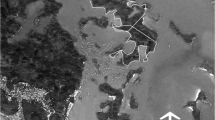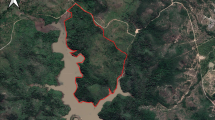Abstract
I examined seasonal, sex, and interspecific differences in activity time budgest and diets of patas (Erythrocebus patas) and sympatric tantalus monkeys (Cercopithecus aethiops tantalus) on the basis of 5-day data sets collected in three and two different seasons, respectively, by the method of focal animal sampling. The seasons included species-specific mating and birth seasons. As compared with not only the birth season but also conspecific females, both patas resident male and tantalus male spent less time feeding and more time resting, day and night, in their respective mating seasons. Given that day-resting time includes time for vigilance for non-resident males and receptive females, this may reflect that males should minimize time spent feeding to allow maximum participation in other fitness-increasing activities such as mating-relating activities asSchoener (1971) predicted. In both species, the males consumed fruits containing less protein but more calories and showed a high feeding rate to compensate for the shorter time spent feeding in the mating season. In contrast, females consumed protein-rich food types (i.e. animals, protein-rich seeds, leaves, and flowers) in the birth season to meet the high demand for protein due to pregnancy and lactation. Given that the season for males was considered to be not a calendar but a reproductive “season” (i.e. mating or birth season), both sexes of patas spent more time moving and less time day- and night-resting than did the tantalus counterparts irrespective of the “season”. Patas subsisted on fruits, gums, and supplementarily lipid-rich seeds as an energy source and animal matters and protein-rich seeds as a protein source. In contrast, tantalus subsisted on fruits and lipid-rich seeds as energy and flowers and leaves as protein.
Similar content being viewed by others
References
Alberts, S. C.;Altmann, J.;Wilson, M. L. 1996. Mate guarding foraging activity of male baboons.Anim. Behav., 51: 1269–1277.
Bicca-Marques, J. C.;Calegaro-Marques, C. 1994. Activity budget and diet ofAlouatta caraya: an age-sex analysis.Folia Primatol., 63: 216–220.
Boinski, S. 1988. Sex differences in the foraging behavior of squirrel monkeys in a seasonal habitat.Behav. Ecol. Sociobiol., 23: 177–186.
Braza, F.;Alvarez, F.;Azcarate, T. 1983. Feeding habits of the red howler monkeys (Alouatta seniculus) in the Llanos of Venezuela.Mammalia, 47: 205–214.
Butynski, T. M. 1988. Guenon birth season and correlates with rainfall and food. In:A Primate Radiation: Evolutionary Biology of the African Guenons,Gautier-Hion,A.;Bourliere,F.;Gautier,J.-P.;Kingdon,J. (eds.), Cambridge Univ. Press, Cambridge, pp. 284–322.
Clutton-Brock, T. H. 1977. Some aspects of intraspectific variation in feeding and ranging behaviour in primate. In:Primate Ecology: Studies of Feeding and Ranging Behavior in Lemurs, Monkeys, Apes,Clutton-Brock,T. (ed.), Academic Press, London, pp. 539–556.
Clutton-Brock, T. H.;Harvey, P. H. 1977. Species differences in feeding and ranging behaviour in primate. In:Primate Ecology: Studies of Feeding and Ranging Behavior in Lemurs, Monkeys, Apes,Clutton-Brock,T. (ed.), Academic Press, London, pp. 557–579.
Cords, M. 1986. Interspecific and intraspecific variation in diet of two forest guenons,Cercopithecus ascanius andC. mitis.J. Anim. Ecol., 55: 811–827.
Cronin, J. E.;Sarich, V. M. 1979. Molecular evidence for dual origin of mangabeys among Old World monkeys.Nature, 260: 700–702.
Cuthill, I. C.;Macdonald, W. A. 1990. Experimental manipulation of the dawn and dusk chorus in the black birdTurdus merula.Behav. Ecol. Sociobiol., 26: 209–216.
Garber, P. A. 1987. Foraging strategies among living primates.Ann. Rev. Anthropol., 16: 339–364.
Garber, P. A. 1993. Seasonal patterns of diet and ranging in two species of Tamarin monkeys: stability versus variability.Int. J. Primatol., 14:145–166.
Gautier-Hion, A. 1980. Seasonal variations of diet related to species and sex in a community ofCercopithecus monkeys.J. Anim. Ecol., 49: 237–269.
Harding, R. S. O;Olson, D. K. 1986. Patterns of mating among male patas monkeys (Erythrocebus patas) in Kenya.Amer. J. Primatol., 11: 343–358.
Harrison, M. J. S. 1983. Age and sex difference in the diet and feeding strategies of the green monkey,Cercopithecus sabaeus.Anim. Behav., 31: 969–977.
Harrison, M. J. S. 1984. Optimal foraging strategies in the diet of the green monkey,Cercopithecus sabaeus, at Mt. Assirik, Senegal.Int. J. Primatol., 5: 435–471.
Harrison, M. J. S. 1985. Time budget of the green monkey,Cercopithecus sabaeus: some optimal strategies.Int. J. Primatol., 6: 351–376.
Henzi, S. P.;Lawes, M. 1987. Breeding season influxes and the behaviour of adult male samango monkeys (Cercopithecus mitis albogularis).Folia Primatol., 48: 125–136.
Hoffman, S. G. 1983. Sex-related foraging behavior in sequentially hermaphroditic hogfishes (Bodianus spp.).Ecology, 64: 789–808.
Isbell, L. A. 1998. Diet for a small primate: insectivory and gummivory in the (large) patas monkeys (Erythrocebus patas pyrrhonotus).Amer. J. Primatol., 45: 381–398.
Isbell, L. A.;Pruetz, J. D.;Lewis, M.;Young, T. P. 1998a. Locomotor activity differences between sympatric vervets (Cercopithecus aethiops) and patas monkeys (Erythrocebus patas): implications for the evolution of long hindlimb length inHomo.Amer. J. Phys. Anthropol., 105: 199–207.
Isbell, L. A.;Pruetz, J. D.;Young, T. P. 1998b. Movements of vervets (Cercopithecus aethiops) and patas monkeys (Erythrocebus patas) as estimators of food resource size, density, and distribution.Behav. Ecol. Sociobiol., 42: 123–133.
Isbell, L. A.;Young, T. P. 1993. Social and ecological influences on activity budgets of vervet monkeys, and their implications for group living.Behav. Ecol. Sociobiol., 32: 377–385.
Kavanagh, M. 1978. National park in the sahel.Oryx, 14: 241–245.
Kavanagh, M. 1983. Birth seasonality inCercopithecus aethiops: a social advantage from synchrony? In:Perspectives in Primate Biology,Seth,P. K. (ed.), Today & Tommorow’s Printers & Publ. Perspect, New Delhi, pp. 89–98.
van der Kuyl, A.;Kuiken, C. L.;Dekker, J. T.;Goudsmit, J. 1995. Phylogeny of African monkeys based upon mitochondrial 12S rRNA sequences.J. Mol. Evol., 40: 137–180.
Letouzey, R. 1980. Vegetation. In:Atlas of the United Republic of Cameroon,Laclavère G. (ed.), Edit. Jeune Afrique, Paris, pp. 20–24.
Meisels, F.;Gautier-Hion, A.;Gautier, J.-P. 1994. Diets of two sympatric colobines in Zaire: more evidence on seed-eating in forests on poor soils.Int. J. Primatol., 15: 681–701.
Miquelle, D. G. 1990. Why don’t bull moose eat during the rut?Behav. Ecol. Sociobiol., 27: 145–151.
Nakagawa, N. 1989. Activity budget and diet of patas monkeys in Kala Maloue National Park, Cameroon: a preliminary report.Primates, 30: 27–34.
Nakagawa, N. 1999. Differential habitat utilization by Patas monkeys (Erythrocebus patas) and Tantalus monkeys (Cercopithecus aethiops tantalus), living sympatrically in Northern Cameroon.Amer. J. Primatol., 49: 243–264.
Napier, J. R.;Napier, P. H. 1967.A Handbook of Living Primates. Academic Press, New York.
Ohsawa, H.;Inoue, M.;Takenaka, O. 1993. Mating strategy and reproductive success of male patas monkeys (Erythrocebus patas).Primates, 34: 533–544.
Overdorff, D. J. 1993. Similarities, differences, and seasonal patterns in the diet ofEulemur rubriventer andEulemur fulvus rufus in the Ranomafana National Park, Madagascar.Int. J. Primatol., 14: 721–753.
Palombit, R. A. 1997. Inter-and intra-specific variation in the diets of sympatric siamang (Hylobates syndactylus) and lar gibbons (Hylobates lar).Folia Primatol., 68: 321–337.
Portman, O. W. 1970. Nutritional requirements (NRC) of nonhuman primates. In:Feeding and Nutrition of Nonhuman Primates,Harris,R. S. (ed.), Academic Press, New York, pp. 87–115.
Post, D. G.;Hausfater, G.;McCuskey, S. A. 1980. Feeding behavior of yellow baboons (Papio cynocephalus): relationship to age, gender and dominance rank.Folia Primatol., 34: 170–195.
Rose, L. M. 1994. Sex differences in diet and foraging behavior in white-faced capuchins (Cebus capucinus).Int. J. Primatol., 15: 95–114.
Rowell, T. E.;Richards, S. M. 1979. Reproductive strategies of some African monkeys.J. Mammal, 60: 58–69.
Ruvolo, M. 1988. Genetic evolution of the African guenons. In:A Primate Radiation: Evolutionary Biology of the African Guenons,Gautier-Hion,A.;Bourlière,F.;Gautier,J.-P.;Kingdon,J. (eds.), Cambridge Univ. Press, New York, pp. 127–149.
Schoener, T. W. 1971. Theory of feeding strategies.Ann. Rev. Ecol. Syst., 11: 369–404.
Schoener, T. W. 1974. Resource partitioning in ecological communities.Science, 185: 27–29.
Silk, J. B. 1987. Activities and feeding behavior of free-ranging pregnant baboons.Int. J. Primatol., 8: 593–613.
Symington, M. M. 1988. Demography, ranging patterns, and activity budgets of Black spider monkeys (Ateles paniscus chamek) in the Manu National Park, Peru.Amer. J. Primatol., 15: 45–67.
Toft, C. A. 1984. Activity budgets in two species of bee flies (Lordotus: bombyliidae diptera): a comparison of species and sexes.Behav. Ecol. Sociobiol., 14: 287–296.
Waterman, P. G. 1984. Food acquisition and processing as a function of plant chemistry. In:Food Acquisition and Processing in Primates,Chivers,D. J.;Wood,B. A.;Bilsoborugh,A. (eds.), Plenum Press, New York, pp. 177–211.
Wheatley, B. P. 1982. Energetics of foraging inMacaca fascicularis andPongo pygmaeus and a selective advantage of large body size in the orangutan.Primates, 23: 348–363.
Author information
Authors and Affiliations
About this article
Cite this article
Nakagawa, N. Seasonal, sex, and interspecific differences in activity time budgets and diets of patas monkeys (Erythrocebus patas) and tantalus monkeys (Cercopithecus aethiops tantalus), living sympatrically in northern Cameroon. Primates 41, 161–174 (2000). https://doi.org/10.1007/BF02557797
Received:
Accepted:
Issue Date:
DOI: https://doi.org/10.1007/BF02557797




